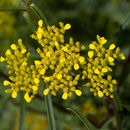Comments
provided by eFloras
Flaveria linearis is variable; it typically has linear leaves, calyculi of relatively short, linear bractlets, and oblong-angular involucres. The heads are relatively small with 5–8 florets, and throats of the disc corollas are tubular at the base, abruptly expanding distally to become funnelform-campanulate. Plants of this species, the most common Flaveria in Florida, occur throughout most of the Florida peninsula, often near the coast.
- license
- cc-by-nc-sa-3.0
- copyright
- Missouri Botanical Garden, 4344 Shaw Boulevard, St. Louis, MO, 63110 USA
Description
provided by eFloras
Perennials, 30–80 cm (glabrous or pubescent, mostly on distal peduncles). Stems erect. Leaves sessile; blades linear, 50–100(–130) × 1–4(–15) mm, ± connate, margins entire or spinulose-serrulate. Heads 10–150+, in clusters in corymbiform-paniculiform arrays. Calyculi of 1–3 linear bractlets 1–2.5 mm. Involucres oblong-angular, 3.3–4.5 mm . Phyllaries 5(–6), linear or oblong. Ray florets 0 or 1; laminae yellow, oval to obovate-spatulate, 2–3 mm. Disc florets (2–)5–7(–8); corolla tubes 0.8–1.2 mm, throats basally tubular, becoming funnelform-campanulate apically, 1–1.5 mm. Cypselae linear, 1.2–1.8 mm; pappi 0. 2n = 36.
- license
- cc-by-nc-sa-3.0
- copyright
- Missouri Botanical Garden, 4344 Shaw Boulevard, St. Louis, MO, 63110 USA
Synonym
provided by eFloras
Flaveria ×latifolia (J. R. Johnston) R. W. Long & E. L. Rhamstine
- license
- cc-by-nc-sa-3.0
- copyright
- Missouri Botanical Garden, 4344 Shaw Boulevard, St. Louis, MO, 63110 USA
Comprehensive Description
provided by North American Flora
Flaveria linearis Lag. Gen. & Sp. Nov. 33. 1816
Flaveria maritime H. B. K. Nov. Gen. & Sp. 4: 285. 1820. Selloa nudata Nutt. Am. Jour. Sci. 5: 300. 1822. Flaveria tenuifolia Nutt. Jour. Acad. Phila. 7: 81. 1834. Gymnosperma nudatam DC. Prodr. 5: 312. 1836.
An apparently perennial plant, shrubby at the base ; stem from erect to prostrate, much branched, 2-8 dm. high, striate, glabrous; lower internodes short and with persistent leafbases; leaves linear, connate and even vaginate at the base, entire, 2-10 cm. long, 1-4 mm. wide; inflorescence irregular; heads in smaller or larger glomerules, 3-5-fiowered; involucral bracts 5, equal, 3 mm. long, the calyculate ones minute; ray-flower usually present; ligule oval, fully 2 mm. long; disk-flowers 2-4; corollas 2.5 mm. long; tube glandular-puberulent, scarcely longer than the throat; achenes 2 mm. long.
Type locality: Havana. Cuba.
Distribution: Florida, Bahamas, and Cuba; Yucatan.
- bibliographic citation
- Per Axel Rydberg. 1915. (CARDUALES); CARDUACEAE; HELENIEAE, TAGETEAE. North American flora. vol 34(2). New York Botanical Garden, New York, NY
Comprehensive Description
provided by North American Flora
Flaveria latifolia (J. R. Johnston) Rydberg, sp. now
Flaveria linearis latifolia J. R. Johnston, Proc. Am. Acad. 39: 289. 1903.
An annual herb; stem greenish or reddish, striate, glabrate, 5-10 dm. high; leaves linear to linear-lanceolate, acute, serrulate or entire, connate at the base, 2.5-10 cm. long, 5-30 mm. wide; heads in rather small glomerules, arranged in an open corymb; involucral bracts 5, elliptic-oblong, 3.5-4 mm. long, the calyculate ones minute or wanting; ligule 2.5 mm. long, 1 mm. wide; disk-flowers 2-5; corollas 2.5 mm. long; tube glandular-puberulent, about equaling the throat; achenes 1.5 mm. long.
Type locality: Lake Worth, near Palm Beach, Florida. Distribution: Florida; Yucatan (?).
- bibliographic citation
- Per Axel Rydberg. 1915. (CARDUALES); CARDUACEAE; HELENIEAE, TAGETEAE. North American flora. vol 34(2). New York Botanical Garden, New York, NY
Flaveria linearis
provided by wikipedia EN
Flaveria linearis, known as narrowleaf yellowtops,[2] is a North American plant species of Flaveria within the family Asteraceae. It is native to Florida, Cuba, Bahamas, and the Yucatán Peninsula of Mexico.[3][4]
Flaveria linearis is a perennial herb up to 80 cm tall. Leaves are long and narrow, up to 13 cm (5 in) long. One plant can produce sometimes as many as 150 small flower heads in a branching array. Each head contains 2-8 yellow disc flowers and sometimes a single yellow ray flower.[2][4]
References

- license
- cc-by-sa-3.0
- copyright
- Wikipedia authors and editors
Flaveria linearis: Brief Summary
provided by wikipedia EN
Flaveria linearis, known as narrowleaf yellowtops, is a North American plant species of Flaveria within the family Asteraceae. It is native to Florida, Cuba, Bahamas, and the Yucatán Peninsula of Mexico.
Flaveria linearis is a perennial herb up to 80 cm tall. Leaves are long and narrow, up to 13 cm (5 in) long. One plant can produce sometimes as many as 150 small flower heads in a branching array. Each head contains 2-8 yellow disc flowers and sometimes a single yellow ray flower.
- license
- cc-by-sa-3.0
- copyright
- Wikipedia authors and editors

